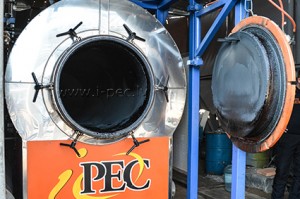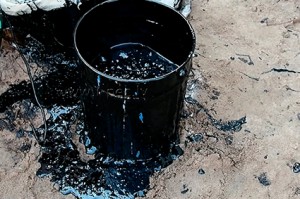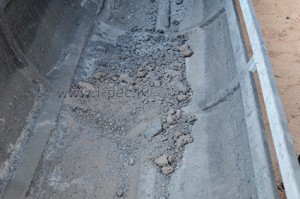Acid tars (or acid sludge) is a toxic residue produced by petroleum processing industry. It is arising due to purification of machines, oil containing products and tanks by concentrated sulfuric acid. Refinery acid tar contains heavy hydrocarbons, sulfuric acid and water. Moreover, it appears to be a highly viscous tar like mass.
The tars are accumulated close to major refineries, in ponds. These acid tars ponds are fit only for temporary storage of hazardous industrial waste, but the storage lasted for decades. The further existence of acid ponds pose a threat to the environment. The main possible solution at international waste management market is a liquidation of sludge ponds.
The sulfuric acid content causing the equipment corrosion and influencing the final product quality is the principal challenge every acid sludge treatment technology collide with.
The prevailing technology is based on oxidation principal for acid sludge treatment. The feedstock is reheated under the high temperatures thus transforming the sulfur dioxide into sulfuric acid. There are other technologies based on either transformation of acid tars to components of road surfaces or sludge mixing with hydrocarbons. However, most the sludge is buried mixed with lime or incinerated that damages the environment.
Since the emergence of such a critical problem the pyrolysis technology put into practice in Thermal Decomposition Plant manufactured by IPEC company which contains the solution for acid tars treatment. To convert the refinery acid sludge into pyrolysis, the first plant was designed by the order of Gazpromneft-Lubricants LTD for its lubricant plant.
Description of treatment process:
— The hopper that is heated by the flues gases feed the raw materials to reduce the viscosity of the sludge
— The feedstock is mixing with neutralized reagent and with water containing ammonia
— Sludge flows the reactor where it is thermally decomposed under the high temperature to the liquid fuel and pyrolysis gaz
— In a multi-stage flue gas cleaning system the flue gases are neutralized, purified and cleaned of acid components.
The pretreatment of feedstock in not claimed; the process of entering happens at the same production line and controlled by automatic system.
The liquidation of sludge pits close out the yearly billion payments of environmental fines.
By obtaining market-grade product such as liquid fuel the economic effect is also achieved. The oil output is approximately equal to 30% per ton of raw material. The pyrolysis oil can be put into practice in generators and boilers.
The plant is able to process a wide range of oil-contaminated waste: crude oil distillation bottoms, heavy oil, oil slime and others. Per year, equipment productive capacity is more than 9000 tons.
To reach the operating parameters, which causes further operating costs reduction, the pyrolysis gas is used as a fuel alternative type. For industrial premises heating, the heat, restored in the process, can be used.
The treatment of 100 kg of sludge will results in 11 kg of dry residue, 30 kg of liquid fuel, 3 liters of water and 38 m3 of gaz. The lack of harmful emissions and clearness of fuel is showed by laboratory testing. As well as economic benefits of acid tar treatment, Thermal Decomposition Plant ensures environmental and industrial safe.
When using the material or any part of it the link to the website (www.i-pec.lv) is required.









